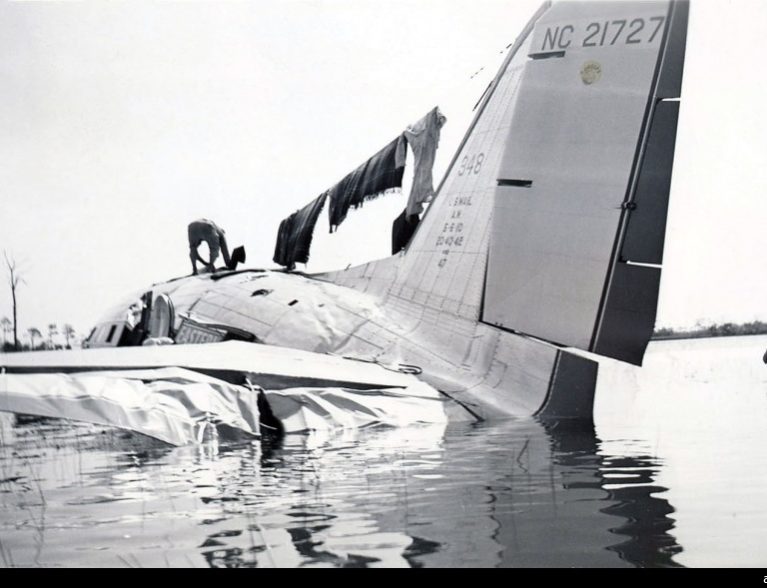
The day before the first board meeting of the newly minted Cleveland Clinic Indian River, a portrait of a somber young man was hung on a conference room wall, the painting’s gilt frame set off by walls freshly painted in a shade jokingly known as Cleveland Clinic White. The frame bears a discrete plate etched with the name Dr. J.B. Kollar.
A modest object recently discovered coated with dust in a hospital storage room, the painting conjures up dramatic events that took place in and near Vero Beach that forged a life-and-death link between the town and Cleveland Clinic nearly 80 years before Cleveland took over the county’s largest hospital.
On April 3, 1941, an Eastern Airlines passenger plane crashed in a swamp 11 miles west of Vero during a violent storm. Onboard was renowned surgeon Dr. George Crile, along with his wife, Grace, and 11 other passengers.
After being rescued, Crile, a co-founder of Cleveland Clinic, was treated at a tiny hospital on Dixie Highway. Many years and several incarnations later, Indian River Hospital would eventually become a part of the Cleveland Clinic, in a merger finalized on Jan. 1.
Adding to the sense of coincidence, it turned out that J.B. Kollar, M.D., the doctor who treated Crile at the little hospital in Vero, had trained with him in Cleveland earlier in his career, according to Dr. Greg Rosencrance, the new president of Cleveland Clinic Indian River.
County historian Ruth Stanbridge knows all about the crash, which she said “was a very big deal” in Vero.
On the day of the accident, Crile and his wife were making the journey back to Cleveland from Africa. The flight that crashed in the marsh had originated in Miami, made a stop in West Palm, and was on its way to Jacksonville when just after 9 a.m. it hit what one account called a tornado.
Several miles from the nearest highway and one mile from dry ground, the pilot, his chest crushed and a leg likely broken, huddled with two crew members and the 13 passengers, nearly all with injuries, in waist-deep water until after nightfall. A plane sent out from Daytona to look for the wreck discovered the half-submerged Douglas DC-3 in the darkness, and set the ensuing rescue in motion.
Harry “Bump” Holman, a barrier island resident whose family has long owned Sun Aviation, remembers hearing all about the crash. His father, the late Bud Holman, flew with the Eastern pilot sent out to search for the missing plane.
“My dad’s the one who spotted the wreck,” said Bump Holman. “Then he got down on Route 60 and waded out in the swamp first. He was the first one that got there.”
With no ambulances in the county, hearses were called to meet the fleet of boats ferrying stranded passengers to dry land a mile from the crash site.
Crile and his wife were the first to be rescued, according to the accounts. “Dr. Crile had a broken rib and was bruised. His wife was cheerful despite the shock and a bruised eye.”
In fact, Crile was severely injured, suffering three fractures to the pelvis, three broken ribs, fractures to the transverse processes of two vertebrae and severe contusions. Grace Crile broke two ribs, her sternum, and a vertebra.
Passenger Dr. Daniel P. Quiring, Crile’s aide at the Cleveland Clinic, who was making his virgin flight, “earned the praise of the passengers for moving about the plane and giving first aid treatment despite the handicap of a dislocated shoulder.”
Crile’s own colorful account of events that day came much later, in an autobiography compiled by his wife and excerpted in a book about the origins of Cleveland Clinic.
The plane left the coast and was flying over mist-covered marshland; Crile noted it reminded him of “waterhole country in Africa.”
Another pilot in the same area, encountering turbulence near Vero, warned the doomed flight’s pilot to stay away. The pilot circled north of West Palm, then forged ahead toward Daytona. According to the FAA investigation, the pilot suddenly encountered “severe turbulence and a violent updraft.”
The pilot told the FAA there was “extremely strong rotation in the updrafts.” In the third and final downdraft they broke through the lowest clouds at around 200 mph. Shortly after, they hit the water.
After five weeks in the Vero hospital, Crile and his wife finally flew home to Cleveland. Not much is known about Dr. Kollar. Stanbridge said she could not recall ever having hearing his name, even though there were only a few doctors in Vero in the 1940s.
The original Indian River Hospital on Dixie south of 12th Street eventually became apartments. The building was seriously damaged in the 2004 hurricanes, and burned down in 2007. That was 61 years after Indian River Hospital had been moved to the old Naval Air Station at the airport, then to a larger building north of Vero’s downtown, and finally, in the 1970s, a much larger complex was built in its current location on 37th Street.
The crash “is a connection that Indian River has with Cleveland Clinic that most of you probably weren’t aware of, and we weren’t, quite frankly, aware of until [now],” Rosencrance told an audience last week at Quail Valley Club.
Crile’s encounter with Vero was brief in the span of a long life. But Rosencrance’s point was clear.
“Every person we touch through healthcare – the caregiver, the patient, the colleague, the community – has an impact. We may not know it at the time, but it’ll have an impact.”



